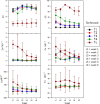Uptake of potentially toxic elements by edible plants in experimental mining Technosols: preliminary assessment
- PMID: 34676509
- PMCID: PMC9033688
- DOI: 10.1007/s10653-021-01091-x
Uptake of potentially toxic elements by edible plants in experimental mining Technosols: preliminary assessment
Abstract
A study was carried out to evaluate the absorption of potentially toxic elements from mining Technosols by three types of vegetable plants (broccoli (Brassica oleracea var. italica), lettuce (Lactuca sativa) and onion (Allium cepa)), the different parts of which are intended for human and farm animal consumption (leaves, roots, edible parts). The preliminary results obtained highlight the importance of the design of the mining Technosols used for agricultural purposes, obtained from soils and sediments of mining origin and amended with residues of high calcium carbonate concentrations (limestone filler and construction and demolition wastes). The experiment was carried out in a greenhouse, and the total metal(loid)s concentration (As, Pb, Cd, Cu, Fe, Mn and Zn) of the soil, rhizosphere, aqueous leachates and plant samples was monitored, the translocation and bioconcentration factors (TF and BCF, respectively) being calculated. The characterization of the soils included a mobilization study in media simulating different environmental conditions that can affect these soils and predicting the differences in behavior of each Technosol. The results obtained showed that the levels of potentially toxic elements present in the cultivated species are within the range of values mentioned in the literature when they were cultivated in soils with calcareous amendments. However, when the plants were grown in contaminated soils, the potentially toxic elements levels varied greatly according to the species, being higher in onions than in lettuce. Experiments with the use of lime filler or construction and demolition wastes for soil remediation result in crops that, in principle, do not present health risks and are similar in development to those grown on non-contaminated soil.
Keywords: Arsenic; Metal(loid)s; Plant uptake; Soil remediation; Technosols.
© 2021. The Author(s).
Conflict of interest statement
The authors declare that they have no conflict of interest.
Figures







References
-
- Abad-Valle P, Álvarez-Ayuso E, Murciego A, Pellitero E. Assessment of the use of sepiolite amendment to restore heavy metal polluted mine soil. Geoderma. 2016;280:57–66. doi: 10.1016/j.geoderma.2016.06.015. - DOI
-
- AFNOR (1993). Norme française NF X 31–109. Qualité des sols. Méthodes chimiques. Determination du carbone organique par oxidation sulfochromique.
-
- Aguilar M, Mondaca P, Ginocchio R, Vidal K, Sauvé S, Neaman A. Comparison of exposure to trace elements through vegetable consumption between a mining area and an agricultural area in central Chile. Environmental Science & Pollution Research. 2018;25(19):19114–19121. doi: 10.1007/s11356-018-2116-x. - DOI - PubMed
MeSH terms
Substances
LinkOut - more resources
Full Text Sources
Research Materials
Miscellaneous

